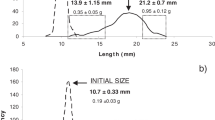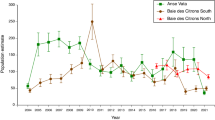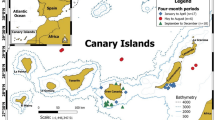Abstract
Chia and Rostron1 have suggested that the planula larvae of the common intertidal anemone Actinia equina L. are liberated, like those of many other species of anemone, into the plankton. They then enter individuals of the same species, male or female, and are nursed in the coelenteron, eventually being ejected as juveniles of various sizes. Their reasons for suggesting this rather unusual sequence are that almost all of the eighty-five individuals they sectioned were either male or female, and that juveniles occurred impartially in both sexes.
This is a preview of subscription content, access via your institution
Access options
Subscribe to this journal
Receive 51 print issues and online access
$199.00 per year
only $3.90 per issue
Buy this article
- Purchase on Springer Link
- Instant access to full article PDF
Prices may be subject to local taxes which are calculated during checkout
Similar content being viewed by others
References
Chia, F.-S., and Rostron, M. A., J. mar. biol. Ass. U. K., 50, 253 (1970).
Elmhirst, R., and Sharpe, J. S., Biochem. J., 14, 48 (1920).
Abeloos-Parize, M., and R., C.r. hebd. Séanc. Soc. Biol., 84, 560 (1926).
Dalyell, Sir J. G., Rare and remarkable animals of Scotland, represented from living subjects: with practical observations on their nature, 2 (van Voorst, London, 1848).
Author information
Authors and Affiliations
Rights and permissions
About this article
Cite this article
CAIN, A. Breeding System of a Sessile Animal. Nature 247, 289–290 (1974). https://doi.org/10.1038/247289a0
Received:
Issue Date:
DOI: https://doi.org/10.1038/247289a0
This article is cited by
-
Biochemical-genetic and ecological evidence that red/brown individuals of the anemone Actinia equina comprise two morphs in Britain
Marine Biology (1983)
-
The sea anemone Actinia equina tolerates allogeneic juveniles but alters their phenotype
Nature (1981)
-
Fortpflanzung und Sexualität vonCereus pedunculatus undActinia equina (Anthozoa, Actiniaria)
Helgoländer Meeresuntersuchungen (1981)
-
Asexual viviparity and population genetics of Actinia tenebrosa
Marine Biology (1979)
-
Genetic relationships between brooding and brooded Actinia tenebrosa
Nature (1975)
Comments
By submitting a comment you agree to abide by our Terms and Community Guidelines. If you find something abusive or that does not comply with our terms or guidelines please flag it as inappropriate.



